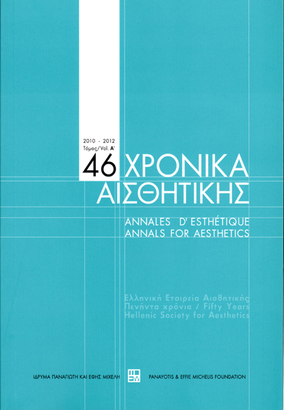Σκέψεις για την τέχνη : τί είναι τέχνη
Part of : Χρονικά αισθητικής : ετήσιον δελτίον της Ελληνικής Εταιρείας Αισθητικής ; Vol.46, No.Α, 2010, pages 119-132
Issue:
Pages:
119-132
Parallel Title:
Thought on art : what is art
Section Title:
Αισθητική - Φιλοσοφία της Τέχνης - Ιστορία της Τέχνης Aesthetics/Philosophy of Art - History of Art
Author:
Abstract:
How and where from does a natural form interpreted by a great artist draw its inexplicable charm, the mystifying beauty that makes us lifelong admirers of a painting, beauty -more often than not- that the original did not possess? Is the “unseen harmony“ of natural forms, such as named precisely by Plotinus, the ultimate goal of artistic creation? And if so, how exactly is this goal achieved by the artist?In art, in order to understand the subject from the point of view of the artist, it is necessary to go beyond its surface, so that the work is convincing in its receptiveness, vitality and truth of any physical form from which it is derived. What is requested is mainly the character of the model, which the artist is trying to represent in his work through drawing, measurement, research on the internal axis of a human figure or the studies on the composition of the work as a whole, the hidden modulus of each creature, the mystical unit that dictates its growth, or, in a single phrase, the uniqueness of its existence. During this process, the dialogue between the artist and the model allows him to conceive and project on the visible side of the model its ideal, where most would see the mundane.The general starting point of artistic creation -even in abstract art- is found, inevitably, in nature, but the artist, as the intermediate factor, subdues its complexity to the unity of his visual goal, in order for the uncorrupted natural energy, combined with his mental energy, to give birth to a new entity, the work of art, composed of the inseparably linked form and substance.Moreover, the Aristotelian definition that “Art is the creative flair of man accompanied by true reason”, underlies the ethical dimension of Art, mirrored in Ingres’s characteristic harsh quote: “I am the tyrant of myself”.The process of creation itself, includes the intrinsic issues of Art, such as drawing, which constitutes the fastest means of communication between thought and act, and volume, a highly complex concept since it correlates in their numerical expression the three dimensions we can sense physically, plus a fourth one, of a mental nature, time. The different researches and solutions in relation to purely visual elements, lead to revolutionary changes in form in different cultural periods.If we accept the above, then, over time the strong artistic personalities, amalgamate through their work their personal endorsements in life with the general one of their era and function as expressers of the conscience of their society. In folk art, in contrast, the creative forces of a nation are collectively recorded, without any prejudice, in all their artistic expressions, creating a common aesthetic approach and transforming everyday life into art and art into life.
Subject:
Notes:
Περιέχει εικόνες




